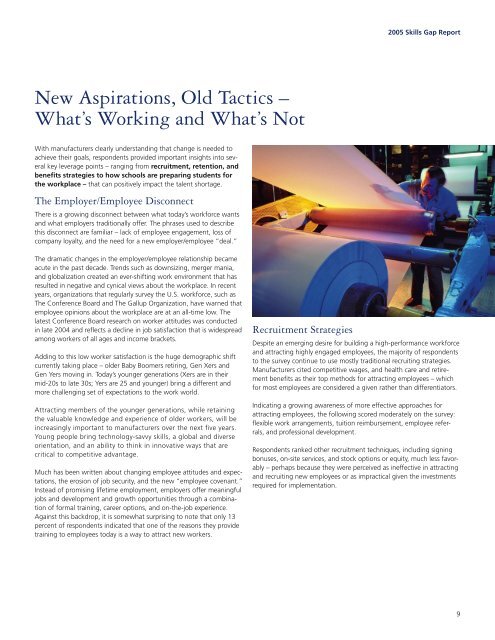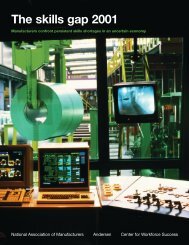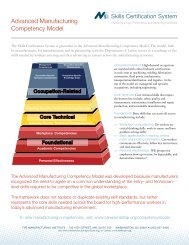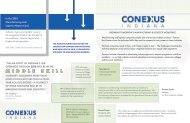2005 Skills Gap Report - Manufacturing Institute
2005 Skills Gap Report - Manufacturing Institute
2005 Skills Gap Report - Manufacturing Institute
You also want an ePaper? Increase the reach of your titles
YUMPU automatically turns print PDFs into web optimized ePapers that Google loves.
<strong>2005</strong> <strong>Skills</strong> <strong>Gap</strong> <strong>Report</strong><br />
New Aspirations, Old Tactics –<br />
What’s Working and What’s Not<br />
With manufacturers clearly understanding that change is needed to<br />
achieve their goals, respondents provided important insights into several<br />
key leverage points – ranging from recruitment, retention, and<br />
benefits strategies to how schools are preparing students for<br />
the workplace – that can positively impact the talent shortage.<br />
The Employer/Employee Disconnect<br />
There is a growing disconnect between what today’s workforce wants<br />
and what employers traditionally offer. The phrases used to describe<br />
this disconnect are familiar – lack of employee engagement, loss of<br />
company loyalty, and the need for a new employer/employee “deal.”<br />
The dramatic changes in the employer/employee relationship became<br />
acute in the past decade. Trends such as downsizing, merger mania,<br />
and globalization created an ever-shifting work environment that has<br />
resulted in negative and cynical views about the workplace. In recent<br />
years, organizations that regularly survey the U.S. workforce, such as<br />
The Conference Board and The Gallup Organization, have warned that<br />
employee opinions about the workplace are at an all-time low. The<br />
latest Conference Board research on worker attitudes was conducted<br />
in late 2004 and reflects a decline in job satisfaction that is widespread<br />
among workers of all ages and income brackets.<br />
Adding to this low worker satisfaction is the huge demographic shift<br />
currently taking place – older Baby Boomers retiring, Gen Xers and<br />
Gen Yers moving in. Today’s younger generations (Xers are in their<br />
mid-20s to late 30s; Yers are 25 and younger) bring a different and<br />
more challenging set of expectations to the work world.<br />
Attracting members of the younger generations, while retaining<br />
the valuable knowledge and experience of older workers, will be<br />
increasingly important to manufacturers over the next five years.<br />
Young people bring technology-savvy skills, a global and diverse<br />
orientation, and an ability to think in innovative ways that are<br />
critical to competitive advantage.<br />
Much has been written about changing employee attitudes and expectations,<br />
the erosion of job security, and the new “employee covenant.”<br />
Instead of promising lifetime employment, employers offer meaningful<br />
jobs and development and growth opportunities through a combination<br />
of formal training, career options, and on-the-job experience.<br />
Against this backdrop, it is somewhat surprising to note that only 13<br />
percent of respondents indicated that one of the reasons they provide<br />
training to employees today is a way to attract new workers.<br />
Recruitment Strategies<br />
Despite an emerging desire for building a high-performance workforce<br />
and attracting highly engaged employees, the majority of respondents<br />
to the survey continue to use mostly traditional recruiting strategies.<br />
Manufacturers cited competitive wages, and health care and retirement<br />
benefits as their top methods for attracting employees – which<br />
for most employees are considered a given rather than differentiators.<br />
Indicating a growing awareness of more effective approaches for<br />
attracting employees, the following scored moderately on the survey:<br />
flexible work arrangements, tuition reimbursement, employee referrals,<br />
and professional development.<br />
Respondents ranked other recruitment techniques, including signing<br />
bonuses, on-site services, and stock options or equity, much less favorably<br />
– perhaps because they were perceived as ineffective in attracting<br />
and recruiting new employees or as impractical given the investments<br />
required for implementation.<br />
9







